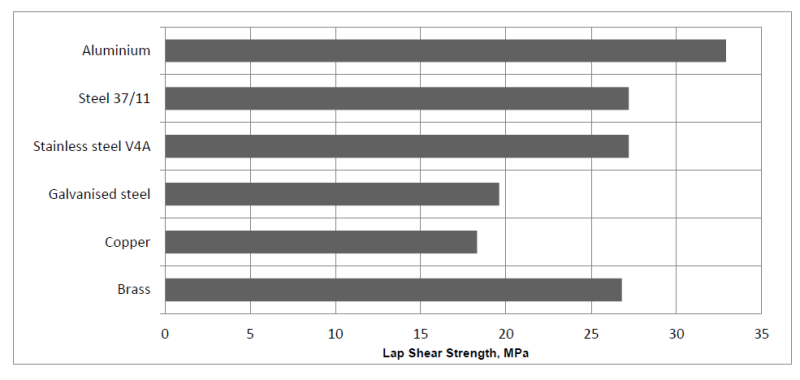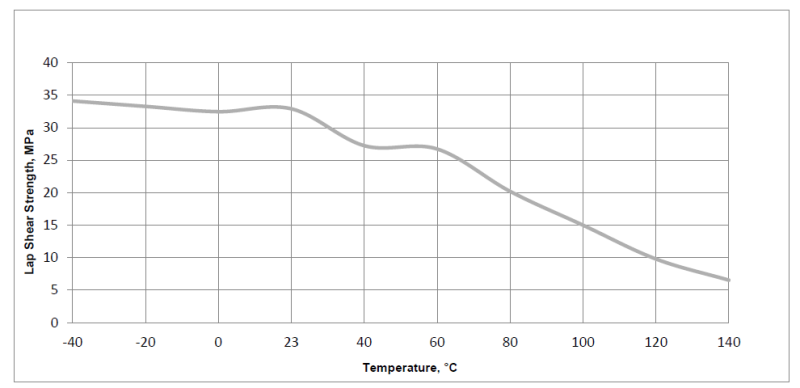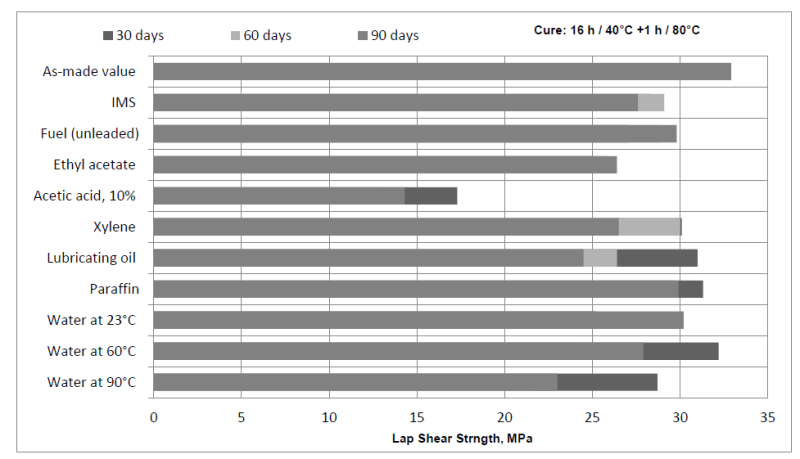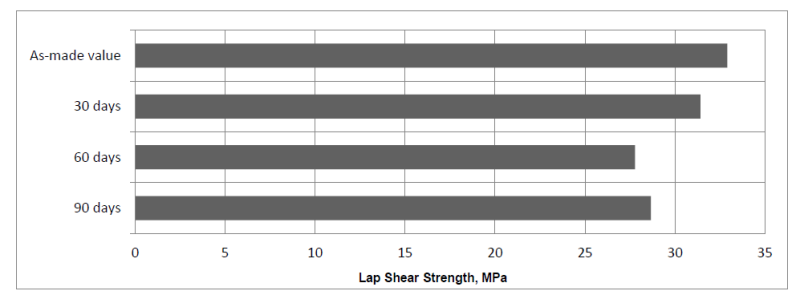Enhanced TDS
Identification & Functionality
Features & Benefits
- Ready-to-Use Product Features
- Product Features
- Very high lap shear
- Bonds a wide variety of materials (metal, composite and thermoplastics)
- Temperature resistant up to 284°F (140°C)
- Extremely tough and resilient adhesive
- Contains spacers to ensure a minimum bond line thickness of 0.05 mm
Applications & Uses
- Compatible Substrates & Surfaces
- Processing Information
Pretreatment
- The strength and durability of a bonded joint are dependent on proper treatment of the surfaces to be bonded.
- At the very least, joint surfaces should be cleaned with a good degreasing agent such as acetone, isopropanol (for plastics) or other proprietary degreasing agents in order to remove all traces of oil, grease and dirt. Low grade alcohol, gasoline (petrol) or paint thinners should never be used.
- The strongest and most durable joints are obtained by either mechanically abrading or chemically etching (“pickling”) the degreased surfaces.
- Abrading should be followed by a second degreasing treatment
Mix Ratio
Product Parts by weight Parts by volume Component A 100 100 Component B 43 50 The resin and hardener should be blended until they form a homogeneous mix. ARALDITE® 2019 A/B is available in cartridges incorporating mixers and can be applied as ready to use adhesive with the aid of the tool recommended by Huntsman Advanced Materials.
Application of adhesive
- The resin/hardener mix is applied with a spatula, to the pretreated and dry joint surfaces.
- A layer of adhesive 0.05 to 0.10 mm thick will normally impart the greatest lap shear strength to the joint.
- If possible, the adhesive should be applied on both substrates and the joint components must be assembled and clamped as soon as the adhesive has been applied.
- For bond line thicknesses below 0.5 mm, the components must be assembled within 60 minutes after the application of the adhesive, for higher bond line thicknesses the components must be assembled within 30 minutes after application of the adhesive.
- An even contact pressure throughout the joint area will ensure optimum cure.
Mechanical Processing
- Specialist firms have developed metering, mixing and spreading equipment that enables the bulk processing of adhesive.
- We will be pleased to advise customers on the choice of equipment for their particular needs.
Equipment Maintenance
- All tools should be cleaned before adhesive residue has had time to cure.
- The removal of cured residue is a difficult and time-consuming operation.
- If solvents such as acetone are used for cleaning, operatives should take the appropriate precautions and, in addition, avoid skin and eye contact.
Cure times to reach minimum shear strength
Temperature, °F (°C) 73 (23) 104 (40) 140 (60) 212 (100) Cure time to reach Lap Shear Strength > 145 psi (1 MPa)
hr
min4.5
--
100-
20-
<5Cure time to reach Lap Shear Strength > 1450 psi (10 MPa)
hr
min6
-2
--
30-
10Curing requirements- To achieve optimum performance properties an elevated temperature cure or post cure is recommended.
- This adhesive will solidify to a hand able state but will not fully cure at temperatures below 140°F (60°C).
Suggested cure schedules in order to improve the heat resistance of the adhesive are the following:- 16 hours at 104F (40°C) + 1 hour at 176F (80°C)
- 3 hours at 176°F (80°C)
- 1 hour at 266°F (130°C)
- 30 min at 302°F (150°C)
- Typical Physical Properties
- Unless otherwise stated, the figures given below were all determined by testing standard specimens made by lap-jointing 114 x 25 x 1.6 mm strips of aluminum alloy.
- The overlap was 12.5 x 25 mm in each case.
- The figures were determined with typical production batches using standard testing methods and are provided solely as technical information and do not constitute a product specification.
Average lap shear strengths of typical metal-to-metal joints (ISO 4587) (typical average values)
Cured for 16 hours at 104°F (40°C) + 1 hour at 176°F (80°C) and tested at 73°F (23°C). Pretreatment - Sandblasting and alcohol degreasing.

Other cure cycles, on aluminum and tested at 73°F (23°C). Pretreatment: sandblasted and degreased.

Average lap shear strengths of typical plastic-to-plastic joints (ISO 4587) (typical average values)
Cured for 16 hours at 104°F (40°C) + 1 hour at 176°F (80°C) and tested at 73°F (23°C). Pretreatment - Lightly abraded and alcohol degreased.

* substrate failure or substrate delamination
Lap shear strength versus temperature (ISO 4587) (typical average values)
Cure: 16 hours at 104°F (40°C) + 1 hour at 176°F (80°C).
Substrate: Aluminium sandblasted and degreased.
Lap shear strength versus immersion in various media (typical average values)
Unless otherwise stated, L.S.S. was determined after immersion for 30, 60 and 90 days at 73°F (23°C). Cure: 16 hours at 104°F (40°C) + 1 hour at 176°F (80°C).
Substrate: Aluminum, sandblasted and degreased.
Lap shear strength versus heat ageing (ISO 4587) (typical average values)
Cure: 16 hours at 104°F (40°C) + 1 hour at 176°F (80°C) and tested at 73°F (23°C).
Substrate: Aluminum sandblasted and degreased.
*25 cycles: -30°C to + 70°C
Lap shear strength versus tropical weathering (typical average values)
Conditions: 40°C / 92% RH
Substrate: Aluminum
Cured for 16 hours at 104°F (40°C) and tested at (23°C)
Pretreatment - Sand blasting
Properties
- Pot Life:
- 1.667 - 2.0 hours
Technical Details & Test Data
- Mechanical Properties (Typical values)
Property Test Method Cure Schedule Value Tg (DSC), °F (°C) ISO 11357-2 16 hours at 40°C 140 (60) 16 hours at 40°C + 1 hour at 80°C 178 (81) 3 hours at 80°C 194 (90) 1 hour at 130°C (216) 102 0.5 hour / 150°C 210 (99) 24 hours at RT + 2 hours at 150°C 252 (122) Roller peel test (sandblasted aluminum), lbf-in (N/mm) ISO 4578 16 hours at 40°C 34-46 (6-8) 16 hours at 40°C + 4 hours at 80°C 5.7-17 (1-3) Tensile strength at 23°C, ksi (MPa) ISO 527 16 hours at 40°C + 1 hour at 80°C 5.8 (40) E-modulus, ksi (MPa) - 16 hours at 40°C + 1 hour at 80°C 232 (1600) Elongation at break, % - 16 hours at 40°C + 1 hour at 80°C 4.3 Flexural strength at 23°C, ksi (MPa) ISO 178 16 hours at 40°C + 1 hour at 80°C 9.4 (65) Flexural modulus, ksi (MPa) - 16 hours at 40°C + 1 hour at 80°C 218 (1500) Durometer Hardness (Shore D) at 23°C ISO 868/03 16 hours at 40°C + 1 hour at 80°C 75 Bend notch test at 23°C/50%RH
K1c, MPa·m1/2
G1c, kJ·m-2ISO 13586 16 hours at 40°C + 1 hour at 80°C 1.7
1.9Shear modulus G’, ksi (MPa) ISO 6721 -- -40°C: 189 (1300)
0°C: 133 (920)
23°C: 116 (800)
60°C: 71 (490)
90°C: 8.7 (60)
140°C: 0.17 (1.2)
Safety & Health
- Safety Information
Keep out of reach of children
Packaging & Availability
- Regional Availability
Storage & Handling
- Storage and Shelf Life Information
- ARALDITE® 2019 A/B should be stored in a dry place, in the original sealed containers, at temperatures between 2°C and 40°C.
- Under these storage conditions, the product has a shelf life of 3 years (from date of manufacture).
- The expiry date is indicated on the label.
- The product should not be exposed to direct sunlight.
- If stored below 60°F, the adhesive should be brought to 60°F - 77°F and conditioned at this temperature for some time prior to use.
Other
- Appearance
- Black paste
- Application Information
Value Units Test Method / Conditions Mix Ratio 0.43 %(W) %(W) Hardener : Resin - Physical Properties
Value Units Test Method / Conditions Density approx. 1.1 g/cm³ g/cm³ Lap Shear Strength1 min. 25.0 MPa MPa Internal Method at 23°C
